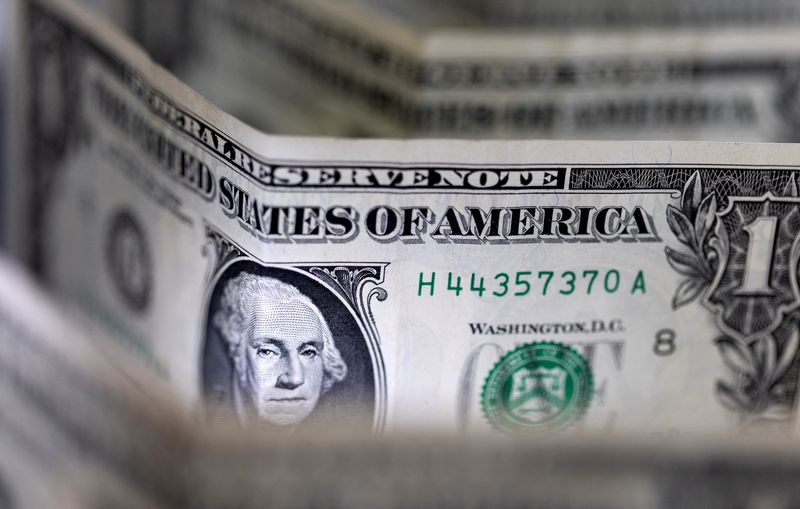By Mike Dolan
LONDON (Reuters) -Central banks around the world are starting to sing from the U.S. Federal Reserve's hymn sheet - and it could well be a coda to the dollar's startling appreciation of the past year.
The European Central Bank's surprisingly large half-point interest rate rise on Thursday was a milestone for many reasons - the first ECB rate rise in more than a decade and the end of an eight-year experiment with negative policy rates.
Even though shy of the Fed's last 75 basis point hike, the choreography in Frankfurt this week owed much to the June move in Washington - last minute anonymous briefings of more hawkish intent and signals on Thursday that all is up for grabs at coming meetings given so-called 'forward guidance' is near pointless in such uncertain times.
In tune with the choir, Bank of England chief Andrew Bailey said on Tuesday the BoE too was considering stepping up its rate rise campaign, with its first half-point hike since gaining independence 25 years ago "on the table" for next month's meeting.
Clearly they have all listened attentively to the advice of their industry association - the Bank for International Settlements - which last month urged all members to act "quickly and decisively" to nip inflation in the bud.
With central banks all admitting visibility is low, ECB chief Lagarde admitted on Thursday that this was a frontloading of rate hikes rather than elevating the entire horizon or so-called "terminal rates". With recession risks in the air and long-term market inflation expectations in the United States and euro zone already back close to central bank targets, this makes sense.
But heightened hawkishness over the coming months - likely as much a political signal to governments, business and wage bargainers as anything - was taken on board by investors nonetheless.
"The greater than expected hike could be the start of more aggressive policy as the ECB has ended forward guidance," said Franklin Templeton's European fixed income chief David Zahn.
Rabobank strategist Bas van Geffen thinks there will be two more 50bps hikes from the ECB in September and October "with upside risks of 75"
And so if signs of "catchup" from other major central banks erodes perceptions of Fed exceptionalism, it could well take the heat from this year's roaring dollar rally - even marking a top after this month's brief flirtation with euro parity and after a near 20% surge on its DXY index since the start of 2021.
It certainly seems to be a moment.
GETTING MIGHTY CROWDED
One of the most striking readouts from this month's global fund manager survey by Bank of America (NYSE:BAC) was that "long U.S. dollar" was now considered the "most crowded trade" on the planet for the first time in more than three years - replacing oil/commodities in that spot for the first time since the Ukraine invasion.
And it chimed for the first time with "hawkish central banks" being identified seen as the "biggest tail risk".
Speculators, at least, have continued to build their biggest net long dollar positions of the year, close to pre-pandemic levels and at levels typically associated with a cresting greenback over the past 20 years.
But if the dollar's stellar rise over the past year owes at least something to the assumption that U.S. interest rates had greater scope to rise post-pandemic than other G7 economies - the Ukraine invasion reinforced that - then the shifting tones in Frankfurt and London this week could now be highly significant for the exchange rate.
Stepped-up European hawkishness speaks clearly to speculation that "reverse currency wars" are at play for many central banks fearful an aggressive Fed will merely exaggerate imported inflation of dollar-priced energy and food and hurt household and business budgets even more.
Lagarde made that point publicly at her press conference on Thursday. "Higher inflation pressures are also stemming from the depreciation of the euro exchange rate," she noted.
Yawning yield gaps need to be reined in to do something about that.
In the 12 months to July 15, the gap between two-year U.S. and German benchmark yields exploded by about 2 full percentage points in favour of the dollar to a peak of 270 bps in total. This coincided with a drop in euro/dollar of more than 18%.
But in the past week, that gap has narrowed by 20 bps.
The inflation-adjusted or "real" two-year gap also hit a three-year high on July 13. It also has recoiled since then.
A huge question is whether the ECB or BoE can keep pace with the Fed even if they want to.
Soundings on the relative economic surprises either side of the pond show the dollar may have priced in much of that already. The dollar's latest leg higher over the past month coincided with euro zone surprises turning negative in mid-June for the first time this year just as U.S. equivalents troughed at their most negative levels since the pandemic hit.
Could it be that the dollar is about to turn at last?
Those who doubt that think Fed expectations will continue to outstrip those surrounding its peers, with Europe lagging and the Bank of Japan remaining a notable refusnik on the tightening front. They also believe the dollar may still benefit from recession stress and that political risks are more pressing in Europe due to its more direct exposure to the Ukraine war as well as Italian and British political uncertainties.

But how much of this is already part of the "most crowded trade"?
The author is editor-at-large for finance and markets at Reuters News. Any views expressed here are his own
(by Mike Dolan, Twitter (NYSE:TWTR): @reutersMikeD; Editing by David Gregorio)